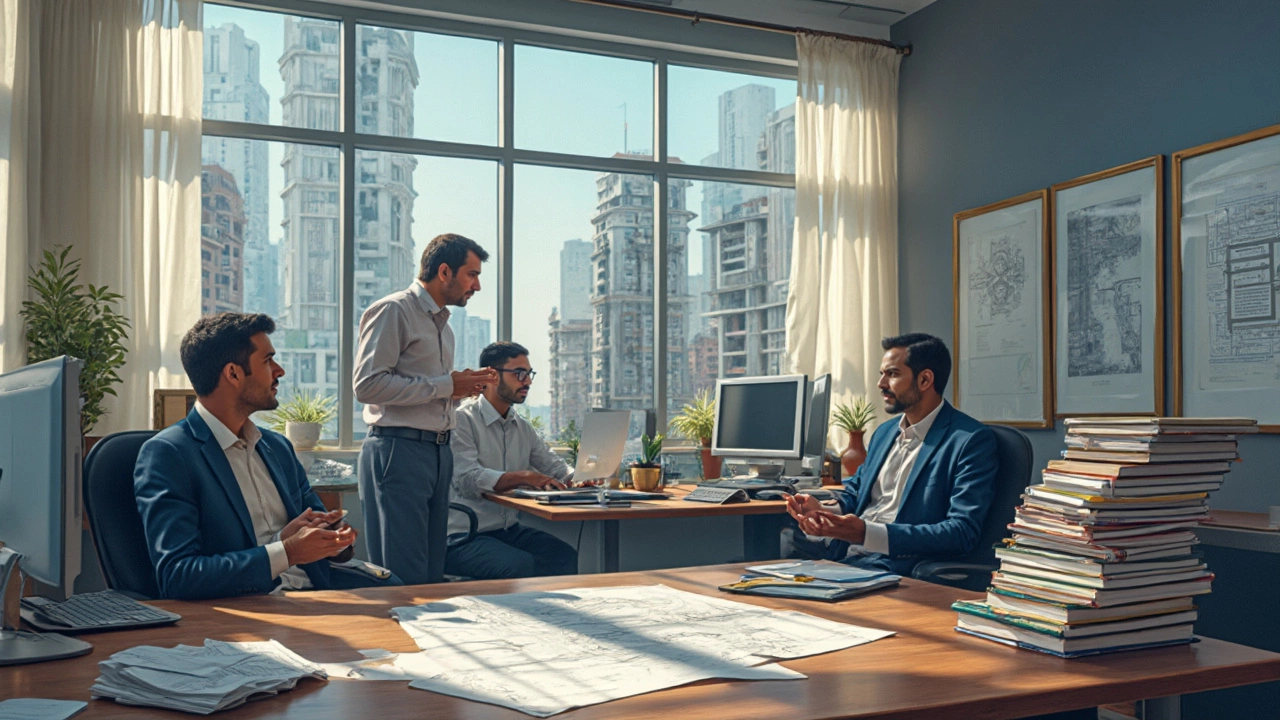Ever stumbled upon a blueprint or design labeled 'licensed for non-commercial use' and felt a wave of confusion? You're not alone. In the world of commercial construction, getting a grip on these licensing terms is more important than finding the right cement mixture.
When we talk about 'licensed for non-commercial,' we're essentially dealing with restrictions. This type of licensing means you can't use the material for any profit-making venture. Pretty straightforward, right? Not always. Imagine you've got a design that's perfect for your new project, but that pesky license stops you from using it to build the latest skyscraper. That's where understanding the nuances saves the day.
- Understanding Licensing Terms
- Implications for Construction Projects
- Real-World Examples
- Potential Pitfalls and How to Avoid Them
- Tips for Navigating Licensing
Understanding Licensing Terms
So, what the heck does 'licensed for non-commercial use' really mean in the construction world? It sounds like a regular snooze-fest, but it's actually super important if you're knee-deep in building plans. This term is all about limits—it ties your hands when you want to use certain materials to make a profit.
Let's break it down. A license generally gives you the nod to use a piece of work—like plans, designs, or even software. But here's the catch: 'non-commercial' means you're not allowed to make dough off it. Kind of like borrowing your neighbor's lawnmower as long as you don't start a landscaping business with it.
What's Allowed and What's Not?
Under this type of license, you can use the work for personal projects, academic studies, or research without any concerns. Planning a potting shed for your backyard? Go for it. But as soon as you start turning those ideas into cash generators, it's a no-go zone.
Reading the Fine Print
Let's not glaze over what you need to check before you dive into using these materials. Here’s a quick checklist:
- Check if derivatives—new works based on the original—are allowed. Some licenses let you tweak while others don’t.
- See if there’s a requirement to give credit to the original creators. Failing to do so might land you in hot water.
- Look for any geographic restrictions—some licenses are valid in specific regions only.
License Types Comparison
To give you a glimpse of how non-commercial licenses stack up, here’s a table comparing different licensing types and what they allow:
| License Type | Commercial Use | Modification Rights |
|---|---|---|
| Creative Commons (Non-Commercial) | No | Sometimes |
| Creative Commons (Attribution) | Yes | Yes |
Basically, understanding these rules is like having a blueprint for your legal safety net—ensuring you build tomorrow’s skyline without demolishing your bank balance with fines.
Implications for Construction Projects
So, what does 'licensed for non-commercial' mean for construction projects? Well, it pretty much puts a hold on using certain designs or plans to turn a profit. If you're involved in commercial construction, it can feel like a real roadblock. However, it doesn't mean you're completely stuck. You just have to be smart about what resources you use and how you apply them.
What You Can and Can't Do
Using materials under this license means they must be free from commercial exploitation. That means no selling, no massive deployments in for-profit projects, and certainly no redistributing as your asset. But, there’s a silver lining. You can still use these resources for educational purposes, research, or any project where cash doesn't change hands.
"The key to making the most out of 'non-commercial' licensed products is to use them as learning tools or inspiration." — Jane Doe, Licensing Expert at BuildSmart
Real Impact in the Field
In real life, ignoring these licenses can lead to legal headaches. For instance, if you use a 'non-commercial' design on a commercial site, you could face fines or orders to stop your project altogether. Not worth the hassle, right?
On the flip side, many construction teams use these materials for prototyping or concept development in the initial phases of a project—an area where you aren’t profiting directly. This approach offers a cost-effective way to experiment and innovate without breaching licensing terms.
Avoiding Common Mistakes
Here’s a quick checklist to keep in line:
- Always read the fine print of a license. If it says 'non-commercial', abide by it.
- Use these materials for educational or experimental purposes within your team.
- Consult with a legal advisor if you're in doubt about specific usage rights.

Real-World Examples
Alright, let's dig into some real-world scenarios where 'licensed for non-commercial' plays a drama-filled role in commercial construction.
Case Study: Community Park Design
Let's say a small town wants to revamp its community park. The community board eyes a sleek gazebo design that they find online. This design is under a 'licensed for non-commercial' agreement. Since the park isn't generating direct revenue, they use it legally. Everyone's happy—except for the local contractor who needs to understand why he can't use the same design for his new apartment project!
The Pitfall with Open Source Designs
Open source design platforms often help DIY builders or enthusiasts. Picture this: a budding architect finds a stunning building design labeled with the non-commercial tag. They decide to adapt it for a friend's boutique hotel without checking the license details—boom, they're in a tricky legal soup once the property starts generating revenue. Moral of the story? Always double-check that license.
Innovative Technology Sharing
In some cases, companies in the construction tech space develop tools or software licensed for non-commercial use. For instance, a software company creates an energy simulation tool to test building efficiencies. Universities and student projects benefit from the tool for research, but any revenue-generating usage in commercial settings, like a consultancy service, hits a wall with the licensing terms.
These stories show how crucial it is to grasp licensing terms. Whether you're a contractor or a tech wizard, knowing where your boundaries lie keeps you safe, sound, and out of court.
Potential Pitfalls and How to Avoid Them
So, you’re all set with your commercial construction project, and everything seems to be running smoothly. But wait—are all your designs and materials truly up for grabs? That's where 'licensed for non-commercial' can throw a wrench in the works if you're not careful.
Common Mistakes People Make
One big pitfall many fall into is overlooking the fine print. When a design or material is labeled as licensed for non-commercial use, using it in a commercial project could spell legal trouble. It’s like borrowing your friend's car—without asking—and then driving it cross-country.
Another common error is assuming a license can be ignored if modifications are made. Changing a few details doesn't transform a non-commercial license into a commercial green light. It's always best to check the specific terms of use before diving in.
Steps to Stay on Safe Ground
- Double-Check the License: Before using any design or material, read the license carefully. If it's labeled non-commercial, steer clear of any money-making plans without permission.
- Contact the Owner: If you're keen on using it, reaching out to the owner might get you the commercial rights you need. It's just a simple case of asking nicely.
- Keep Documentation: Always document any permission received in writing. It’s your shield if questions ever arise.
- Consult a Legal Expert: If in doubt, seek advice from someone who knows the ins and outs of usage licensing. Better safe than sorry, right?
By adhering to these guidelines, you’ll sidestep legal headaches and get your project on the right track. Remember, being informed and proactive beats dealing with a construction nightmare later on.

Tips for Navigating Licensing
Getting a handle on 'licensed for non-commercial' can feel like trying to assemble flatpack furniture without instructions. But don’t stress, I've got a few rock-solid tips to help you steer through this.
Read the Fine Print
First off, always read the full license. Seems like common sense, right? But you'd be surprised how often folks miss this step. Licenses usually outline exactly what's allowed and what’s not. Some even offer exceptions under specific conditions. So grab a coffee and dive into the details.
Consult a Legal Expert
If the license language leaves you more puzzled than a mystery novel, it's time to bring in the pros. A legal expert familiar with construction or intellectual property can break down those terms faster than you can say 'compliance'.
Consider Alternatives
Can't use that stunning design you found? It might be time to look for alternatives. Numerous databases and platforms offer construction resources with commercial licenses. It might mean a different path, but it keeps you on the right side of the law.
Negotiate for a Different License
Don't shy away from reaching out to the creator. Sometimes, they're open to negotiating a different type of license for a fee. It's like haggling in a market but with architects and designers.
Keep Good Records
Document everything. From the licenses you acquire to any communication with creators. Good record-keeping can be a lifesaver if your 'non-commercial' use ever gets called into question.
These tips should save you a headache or two, and keep your projects running smoothly within the bounds of the law. Remember, understanding these licenses isn't just legal mumbo jumbo—it's about protecting your work and respecting the creators.



Write a comment